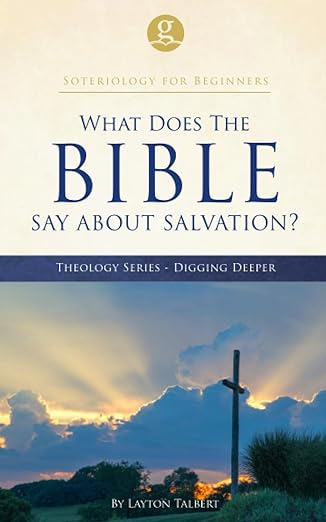
Soteriology for Beginners … and Others

Looking for a discipleship series for individual or group study? Tim Richmond, pastor of Grace Baptist Church of Queens in NYC, is in the process of overseeing a mini theology series aimed at grounding new believers, but with plenty of meat to feed seasoned believers as well. One-hundred-page (ish) volumes include studies on Bibliology (Mark Ward) and Christology (Thomas Overmiller). Others are in the works. It was my privilege recently to contribute the latest volume, What Does the Bible Say About Salvation?.
I was raised Roman Catholic, though I was never particularly religious. It was not until I was a young teenager that I first heard the gospel. My physician father divorced my mother when I was 13 (the youngest of four siblings), shattering our home life. But as Joseph said of his brothers’ sins against him, they meant it for evil but God meant it for good (Gen 50:20). That was the wedge God graciously used to break into our family, disturb our illusions of security, and begin to draw each of us—one by one—to himself (including, eventually, my dad). Once God persuaded me to trust Christ at the age of 15, he put me on a path that has led to my giving a significant part of my life to studying and teaching the biblical doctrines of salvation explored in this book.
The book is written in the second person. That was a purposeful choice—not to talk about what happens to “someone” when he or she believes the gospel, but what happens to you when you believe the gospel. That’s because salvation is very personal. Here’s how the first chapter opens:
You are inside a story. You always have been. And once you’re in, there’s no getting out of it. The story is much bigger than you, of course. Everyone is in this story. But unlike the characters in other stories, you are a living, choosing person within this story; and you know the Author. This is the Story of the World, the Story of Reality. And the one telling it is God. Stories often begin, “Once upon a time.” This story starts, “In the beginning” (Gen 1:1).
A distinctive feature of this study is that it unfolds the systematic theological doctrines of salvation within the larger biblical theological context of the Bible’s redemptive storyline.
The Bible is an inherently redemptive story—which is to say, it is an inherently soteriological book. Soteriology is not merely one of many doctrines taught in Scripture; it is a dominant thematic undercurrent that propels the redemptive plot and drives the Bible’s storyline. . . . So, soteriology is not just a doctrine you believe, but neither is it a story you merely read. It is a story you experience because it is a story you are in.
The Bible itself begins not with the redemption theme, but with a race of beings created in the image of God and granted dominion over the physical world (Genesis 1-2). And the Bible ends not with the redemption theme, but with those created and redeemed beings exercising the dominion over the recreated physical world for which they were originally fashioned. In other words, the redemptive storyline is, itself, set within the even larger framework of the Bible’s kingdom storyline. I try to illustrate it this way:
A forest usually has an “understory” and an “overstory.” The understory is the dense layer of undergrowth—shrubs, saplings, grasses—that make up the forest floor up to perhaps 10–12 feet. The overstory is the forest canopy, an overarching layer of tall pines and oaks. Redemption (salvation) is the understory—the dense, groundcover storyline of the Bible at eye-level. But that redemptive understory happens under the higher, overarching, canopy storyline—the overstory—that is easy to lose sight of at ground-level. The overstory is the kingdom storyline, the theme of restoration to the dominion with which the whole story begins and ends. The last “chapter” of the story makes the linkage between these two storylines explicit, when Christ is praised for His redemptive work and its result: “You were slain, and have redeemed us to God by Your blood . . . and we shall reign on the earth” (Rev 5:9–10). Redemption and dominion are inextricably connected.
Here’s what the book covers and how it progresses.
- Chapter 1 (Sin: In the Beginning) is grounded in Genesis 1–3 and covers Creation, Fall, Depravity, Redemption, and the Nature of Sin.
- Chapter 2 (Atonement: God’s Provision for Your Salvation) recommends 1 Peter 1–3 as the preliminary reading, and surveys Atonement, Substitution, Active and Passive Obedience, and (briefly) Atonement Theories.
- Chapter 3 (Conversion: How Was It That You Came to Come to Christ?) starts with a recommended reading of Acts 1–3, and covers Calling, Drawing, Conversion, Repentance, Faith, and Regeneration.
- Chapter 4 (Reconciliation: How Were You Brought Back into Right Relation with God?) recommends beginning with a reading of Romans 1–3 and explores Propitiation, Justification, Imputation, Redemption, Forgiveness, and Reconciliation.
- Chapter 5 (Union with Christ: Your Life Is Hidden with Christ in God) recommends reading Colossians 1–3, and then focuses entirely on the concept of Identification with Christ.
- Chapter 6 (Growth: Becoming a Partaker of the Divine Nature) draws attention to 2 Peter 1–3, and focuses on Sanctification, Perseverance, Preservation, Security, and Assurance.
- Chapter 7 (Glorification: The Unending End of the Story) suggests several preliminary readings (1 Corinthians 15; Romans 8; Revelation 21–22) and surveys Glorification, Heaven, Resurrection, Adoption, and the New Earth.
- Chapter 8 (Election: Before the Beginning) turns the reader’s attention to Ephesians 1–3 and addresses Foreknowledge, Predestination, and Election.
Each chapter concludes with a list of questions for review, reflection, and/or discussion. The chapters are framed between a Prologue (The Story of Salvation) and an Epilogue (Once Upon a Tree), the latter being a mini biblical theology of tree imagery throughout Scripture. Included as an appendix is a concise Glossary of Soteriological Terms.
Written as a discipleship tool, What Does the Bible Say About Salvation? presents a comprehensive yet concise summary of soteriology. While it does not avoid hard topics, it avoids bogging down in them. Saturated with Scripture, this soteriological guide aims at helping you think God’s thoughts about why and how he saved you and what that means for how you live life.
(Available on Amazon in both Kindle and paperback)

